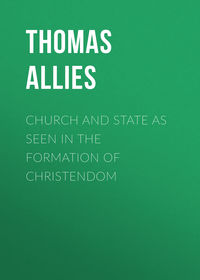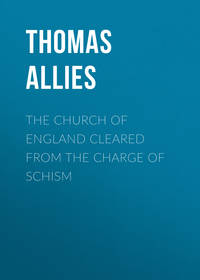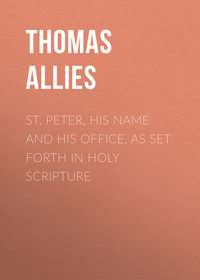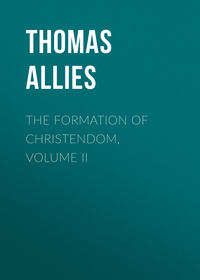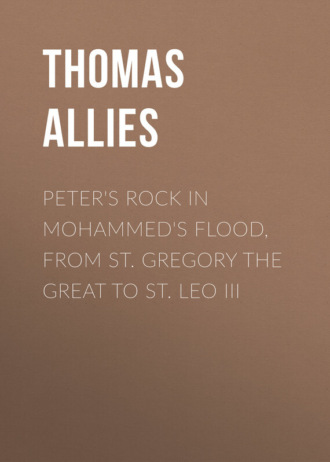 полная версия
полная версияPeter's Rock in Mohammed's Flood, from St. Gregory the Great to St. Leo III
At this time St. John the Almsgiver – the last great patriarch of Alexandria – gave every help to the fugitives from the Persian seizure of the Holy Land. It is a sign of the secular power wielded by the Egyptian patriarch that he ordered the confiscation of the goods of those who used in his city false weights and measures. After he had lovingly received and supported the fugitives from Syria and Palestine, he had, in the next year, 616, to fly himself in order to escape the sword of the Persians. He was on his way with the patrician Nicetas to Constantinople, when, at Rhodes, he had a vision, in consequence of which he said to his companion: “You invite me to the king of this world, but the Lord of heaven comes before you”. He told Nicetas the vision, and left him to go to Amathus in Cyprus, his birthplace. There he made his will in these words: “I thank Thee, O Lord, that Thou hast heard my prayer, and that only one-third of one gold piece remains to me, though at my consecration I found 8000 pounds' weight of gold in the bishop's house at Alexandria, not reckoning those countless sums which I have received from the friends of Christ. Therefore, I order that this small remnant be given to Thy servants.” Ten years he sat in the See of Alexandria. George was his successor. But from this time nothing more is known of this Church's history. Alexandria fell first under the Persians, and then under Amrou, the Mohammedan. The Arabian domination supported Christian errors only, and from that time the Church of St. Athanasius has never lifted its head again, and the land of the Desert Fathers is become the chief seat of the religion which puts an impostor in the place of the Redeemer.
In the year 616, the Persians broke into Egypt, took and plundered Alexandria, and carried their ravages to the borders of Æthiopia. Another Persian army besieged Chalcedon. Still Heraclius remained inactive. He only sent an embassy to Chosroes. In 619 he sent another, beseeching mercy in the name of the senate. Chosroes replied: “I will spare the Romans when they renounce their Crucified One and worship the sun”. He remembered not that he had to thank the Romans for his crown, that in his time of trouble he had found help only from the God of the Christians. Heraclius lost courage at this answer. Since the loss of Egypt Constantinople was suffering from famine, as well as a grievous pestilence. The emperor resolved to quit his capital, and take refuge with his father in Africa. He embarked his chief treasures, and directed the fleet to Carthage. Most of it was wrecked in a storm. A panic fell on his people, and they besought him with tears and cries not to forsake them. The patriarch Sergius went to the palace, led Heraclius to Sancta Sophia, and compelled him before the altar to swear aloud not to desert his capital. Heraclius submitted against his will.
In 619 he was very nearly taken captive by the Khan of the Avars, who had asked him for an interview, ostensibly to settle terms of peace, in reality to secure his person and riches, and to fall upon Constantinople. The emperor came in great pomp, was surprised, and scarcely escaped in disguise. The Avars obtained an immense booty, and, according to the patriarch Nicephorus, carried away captive beyond the Danube 270,000 men, women, and children.
At length, in the twelfth year of his reign, Heraclius awoke from his torpor, and his awakening was one of the most marvellous events recorded in history. His treasury was empty and his credit not good enough to borrow; but he resolved to attack the Persians in their own country. To secure Constantinople he made peace with the Avars, and to hold them in check he ceded provinces to other races, Slaves, Croatians, and Servians. He made churches and monasteries supply a forced loan. He took even the candlesticks and holy vessels of Sancta Sophia and coined them. When all was ready for his departure, he declared his eldest son, Heraclius Constantinus, ten years old, regent of the kingdom under tutorship of Sergius the patriarch and Bonosus, patrician. Then he celebrated the Easter festival, 4th April, 622. The next day he went to Sancta Sophia, threw himself before the altar and cried: “Lord, deliver us not for the punishment of our transgressions to our enemies, but look upon us in Thy mercy and grant us victory, that the wicked cease to exalt themselves and to mock Thine inheritance”. Then he turned to the patriarch Sergius with the words: “My city and my son I leave to God's protection, the Blessed Virgin's, and thine”. Upon this he took into his hands an image of our Saviour, which was said not to have been made by hands, marched to the Bosphorus and crossed over to Asia.
A train of defeats by the Persians had demoralised the Greek soldiers. Heraclius reinforced his army with allied troops, amongst them a number of Turks. He spent some months at first in restoring courage to his forces. “See,” he said, “my children, how the enemies of God trample on our land, lay waste our cities, burn our sanctuaries, desecrate our altars, pollute our churches with the vilest abominations.” When he had thus enheartened them he reviewed them together, and swore to fight with them and on equal terms unto death, to share all their dangers, to be inseparable from them as a father with his children. And moreover, he kept his word.
Heraclius was ever at the head of his soldiers: he united valour with caution: he entered Armenia and defeated the Persians in several battles. Then he made a show of taking up his winter-quarters in Pontus, but suddenly burst into Persia, and utterly discomfited a large force. He took the enemy's camp, together with immense treasure. His troops were astounded at their own victories, and he wintered them in Armenia. The next campaign was no less glorious. He kept Easter Day in 623, which fell on the 27th March, with his family at Nicomedia. By the 20th April he was in Persia. He had written to Chosroes, and offered him peace. The Persian king not only rejected his offer, but put the bearers of it to death. Heraclius used all these circumstances to give courage and confidence to his troops. He penetrated to the heart of Persia: he burnt the cities and villages which he passed on his way, and marched on Ganzac, now Tauris, where Chosroes was encamped with forty thousand men. At the first onset, Chosroes took flight. His troops were mown down, captured, or scattered. Ganzac was the capital of Atropatene. The Persian kings kept there a treasure, said to be that of Crœsus and to have been brought thither by Cyrus. The most renowned fire-temple of the chief god of the Persians was in this city. Here Zoroaster, the founder of that worship, had been born and lived. There was also here a colossal statue of Chosroes. He was seated in the middle of the palace under a great baldachin representing heaven. Round him were the sun, moon and stars, and angels bearing sceptres. The statue, by means of machinery, caused rain to fall, and thunder to sound. In fact, Chosroes assumed here divine worship. The emperor ordered the statue to be overthrown and broken to pieces. Heraclius burnt palace and temple, with part of the city. Then he marched into Albania for the winter, and, out of pity, set free fifty thousand Persian prisoners, to whom he likewise gave maintenance. This humanity so won their hearts that they burst into tears, and prayed that he might restore freedom to Persia, and put to flight Chosroes, whom they called the Waster of the human race – so hateful had he made himself by oppression and cruelty.
In the campaign of 624, Chosroes brought up three armies against the emperor. Heraclius defeated them in three great battles. He made so sudden a night attack upon what remained that their general, Sarbar, wakened by the clash of arms, had scarcely time to spring from his bed on horseback, and ride away at full speed, while the conqueror took possession of his golden shield, and even his clothes. In his fourth campaign, that of 625, Heraclius was also victorious. Chosroes avenged the defeat of his troops by falling on the churches of Persia, which he stripped of all their ornaments: and to punish the emperor, he compelled the Christians of his realm to become Nestorians. Fifteen years before, he had, to please his physician, compelled the inhabitants of Edessa to become Eutycheans. Chosroes rallied all his forces for the campaign of 626. He raised three great armies, composed indifferently of freemen and slaves, of natives and foreigners. Sarbar led one of these armies to Chalcedon to besiege Constantinople, on the Asiatic side, while the Khan of the Avars, breaking truce, appeared on the European side, to demand the surrender of the city and all its wealth. Its inhabitants, however, defended themselves with such valour as to repulse both Avars and Persians. The fall of the Avar power begins at this moment. It was henceforth occupied by intestine struggles. Sais led the second army of Chosroes, which was defeated by Theodore, brother of the emperor Heraclius. Heraclius himself broke the third army under the command of Rhazates, at Nineveh, on the 12th December, 627. The battle began in early morning, and ended only in the evening. The Persians lost, besides the commanding general, his three lieutenants, almost all their officers, and nearly the half of their soldiers. The Romans had only fifty killed, but many thousands wounded. These the emperor tended with so much care that only ten died.
Nineveh, at that time, was only a village on the ruins of the old capital. Heraclius marched thence upon Ctesiphon, the capital of Persia, built upon the remains of old Babylon, at a little distance. On his road he passed palaces, seats, and chaces wherein the Persian nobles pursued their hunting. Heraclius suffered his soldiers to sack and burn them all. Chosroes fled from city to city. Heraclius made him new peace-proposals at the beginning of 628. Chosroes refused them all, and became perfectly hated by the Persians. He thought not of the justice of God, which was pursuing him. Thirty-eight years before he had murdered his father Hermisdas to obtain his throne. What he had done to his father was to happen to him from his eldest son. He had been struck by a violent dysentery: and wished to make Medarses, his son by his favourite wife Syra, a Christian, his successor in the throne. His eldest son, Siroes, irritated by this preference, gained the nobles and the army, was proclaimed king, and sent an embassy to Heraclius. Chosroes was captured in his flight, and brought to Ctesiphon, on the 24th February, 628. He was put in chains and imprisoned in the strong tower, Tenebres, which he had built to keep his treasures. The next day Siroes was crowned: the first act of his government was to condemn his father to die of starvation. “Let him eat,” he said, “the gold for which he has desolated the world, and condemned so many to die of hunger.” The Satraps and all his enemies were made to mock the fallen ruler, and spit in his face. Siroes ordered Medarses and all his brethren to be strangled before his father's eyes: and, as the old king was still living on the fifth day, had him shot to death with arrows. So ended Chosroes, king of Persia, murdered by his son as he murdered his father.
These victories the emperor Heraclius reported at Constantinople, and also sent a letter, in which Siroes announced his coronation, and proclaimed his wish for peace. This letter was read from the ambo of Sancta Sophia on the Feast of Pentecost, 15th May, 628.
Siroes, in fact, established a stable peace with the emperor. He restored him all Christian prisoners in Persia, among them, Zacharias, patriarch of Jerusalem. He delivered to him also the true Cross, which Sarbar had taken away fourteen years before at the capture of Jerusalem. This was at first carried to Constantinople: but in the following year, 629, the emperor took ship to bring it back to Jerusalem, and give thanks to God for his victories. Here he replaced the Cross on its old spot. It had remained in its case, as it was taken away. The patriarch, with his clergy, recognised the seal as intact, opened with its key the shrine, worshipped the Cross, and showed it to the people. The Church celebrates, by the Feast of the Exaltation of the Holy Cross, this event on the same day, the 14th September, on which she had before celebrated the apparition of the Cross to Constantine. Heraclius, in the same year, came to Edessa, and restored to the Catholics the church which Chosroes had given to the Nestorians. And he paid back, in the shape of a yearly income to Sancta Sophia and its clergy, the sums which he had borrowed for the costs of the war.
Let us dwell for a moment on these acts of Heraclius, from 622 to 629.
No Roman emperor, in the course of many hundred years, during the whole time in which Rome and Persia stood as rivals over against each other, obtained such a triumph over the king of kings, as did Heraclius. He surpassed by far Trajan at the culmination of the empire. Heraclius, commending his city and his son to the protection of God, of our Blessed Lady, and of the bishop of his city, God's representative, went forth on what seemed a desperate expedition, borrowing from churches and monasteries the means to equip it. For seven years victory crowned his course. Trajan stopped at the Mesopotamian provinces. Julian perished in them. Mark Antony won no honour of Rome's eastern rival: Crassus and his host never returned. Galerius was stuffed and served as a footstool for the great king to mount on horseback. Into the heart of that eastern realm Heraclius threw himself fearlessly. He made his own army out of divers peoples, and shared their dangers. Host after host he overthrew, as only the son of Philip, the conqueror without his match, had done before him. In the end, on the very spot where a Roman emperor, the special despiser of the Nazarene, and fostering in his heart the destruction of the Church as the crowning work of his reign, to be achieved upon his return as conqueror, perished by a Persian lance, Heraclius, after driving to despair the great king, the persecutor of the Cross, its possessor by conquest, saw him dethroned, famished, and at last shot to death by his son. He received from that son, the successor of the murdered father, abundant satisfaction for the wrongs which the Roman empire had suffered from its great rival of so many hundred years.
But, moreover, during these very seven years in which Heraclius won a perpetual victory in the name of the Cross – the wood of which he brought back as a conqueror to Jerusalem, giving thanks and worship, and replaced it with the seal which guarded it unbroken in its old sanctuary – an Arabian trafficker who had gained his living by carrying goods from city to city, and lived virtuously with one wife much his elder, upon her death, when he was more than fifty years of age, was assuming the name of a prophet and the position of a conqueror. The year in which Heraclius started is the same in which this pretension was set up. His claim to be a prophet is exactly coincident with the years in which he was taking to himself wife after wife, in which, entering suddenly the tent of his adopted son, he was seduced by a casual glance on that wife's beauty to desire her, to obtain her, and to forge a permission from the Most High to take as many wives as he pleased, and the wives of others – a forgery as yet unique in all the history of imposture; for many bad men have taken the wives of others, but no one except Mohammed has pretended to have a divine sanction for an act which treads under foot all human justice, and pulls down for the lust of one man the very foundation of domestic life.
It is of this man that one who has analysed his religion and described its course opens his work with these words: —
“Since the beginning of the world has no other man – mere man – ever exerted so boundless an influence on the human race in the relations of religion, morality, and polity as Mohammed, the Arab. A man, by no means one of those rare spirits whom Providence at times evokes and endues with genius to open a path for a new world – a man rather whose mind was enclosed in narrow limits, poor in ideas for the construction of a new religion: a man such as this has for twelve hundred years cast his net of artless yet impenetrable links of doctrine round a hundred million souls – roots of teaching which have sunk into the marrow of men's minds, have taken up into themselves and mastered the whole of life, and impressed a uniform stamp on the thoughts and deeds of races as well as individuals.”
The seven years of Heraclius form part of the ten years of this Mohammed, in which the trader turns prophet and the reformer of religion endeavours to put a divine sanction on polygamy, in conjunction with a boundless concubinage of which captives were the prey.
As eighteen years of continual defeat by the Persians, from 604 to 622, had reduced the Eastern empire to a state of demoralised weakness, so the seven succeeding years, from 622 to 629, in which Heraclius wrought a full revenge on the Persian king, inflicted no passing collapse upon the empire resuscitated by the Sassanides in the third century. King Siroes did not long enjoy the fruit of his parricide. He reigned six months and then he died – some say of the plague, some of remorse. After his death the throne of Persia seemed to become a seat of murder. His young son, Ardeschir, or Artaxerxes, was killed after reigning seven months by his uncle, the general Sarbar. Sarbar kept the throne two months and was killed. Devanschir took his place. He was followed by Borane, a daughter of Chosroes. She was replaced by a certain Tschaschindeh, who was followed by Borane's sister, Azermidokt. A certain Kesra, or Chosroes, succeeded, and he gave way to a Ferokzad. Finally, Jezdedjerd, a grandson of the last Chosroes, was crowned in the year 632. Thus in the short space of four years about nine persons succeeded to the throne by murder. Jezdedjerd III. began his reign in the year Mohammed died. He is called by Theophanes, Hormisdas. He had the honour to be the last king of Persia and to end his days by the sword of the Arab in 651. His son, Peroxes, became a captain in the life-guards of the emperor of China at Singapore, and left no posterity.
After this glimpse at the action of the Byzantine and Persian empires on each other during the thirty years which follow immediately on the death of St. Gregory, we turn to consider the conduct of the temporal liege-lord of the Pope towards him whom he recognised as successor of St. Peter.
The emperor Phocas, following in this his predecessor Justinian, had expressly enjoined on the patriarch of Constantinople to recognise the Primacy of Rome. What the chroniclers remark is important, that Boniface III., the next to succeed St. Gregory, received a decree from Phocas, in which he solemnly declared that the See of the Roman Church was to be considered the head of Christendom. It may be remarked here that Phocas did not say a word more than his predecessor, Marcian, said to St. Leo a hundred and fifty years before. Phocas may be named a tyrant, but Marcian has left an unspotted reputation as a Christian king and Roman prince, who received the empire with the hand of Pulcheria, heiress of the great Theodosius, and the only descendant worthy of his greatness, whose name stands also on the diptychs of the Catholic Church as a virgin saint.
Upon the history of the City of Rome during the first half of the seventh century the greatest obscurity rests. It was indeed the most frightful and destructive century for the former queen-city of the world. The Book of the Popes by Anastasius trickles in a slender thread amid war, famine, and pestilence, and inundations of the Tiber; but it is all we have to look at.
With the death of the great Pontiff, who guarded and fed his city while the calamities which he saw all round the sphere of his vision over the whole Church led him to look for the end of the world, the See of Peter remained half a year unfilled until his successor, Sabinianus of Volterra, formerly Papal Nuncio at the Byzantine court, received the confirmation of his election from the exarch or the emperor. The confirmation of each pope's election was, as a rule, obtained either from the exarch or direct from the emperor. It was a business both costly and protracted. It also made the spiritual head of Rome dependent for his recognition on the imperial court. I find that in the period of 111 years, running from the death of St. Gregory in 604 to the death of Pope Constantine in 715, twenty-four popes succeeded. Of these the first, Sabinian, in 604, had to wait six months. Phocas confirmed the election of Boniface III., the next pope, after a year. He died in November, 607, and Boniface IV. following took his seat in August, 608. When he died, Pope Deusdedit waited five months. At his death Boniface V. succeeded after a year, in 619. Pope Honorius followed Boniface in five days and sat during thirteen years, but at his death the confirmation of his successor, Pope Severinus, was delayed by Greek intrigue, and for a purpose hereafter to be mentioned, during nineteen months and sixteen days, so that he only sat from the 28th May to the 1st August, 640. St. Martin in 649 did not wait for the imperial confirmation; he was first banished and then martyred by the emperor Constans II., who put in by threats his successor, Eugenius, during his lifetime. St. Leo II. waited eighteen months in 682, after the death of Pope Agatho, and the next Pope, Benedict II., a year in 684.
This privation of its original freedom, according to which the Pope's consecration followed at once upon his complete and legitimate election by clergy and people, the Roman Church owed to the Arian Herule Odoacer, during his occupation of Italy. It was eagerly grasped, after Theodorich and Theodatus had exercised it, by Justinian, when he became, by conquest, lord of Rome. I have already recorded the infamous violence exerted by Belisarius as soon as he had entered Rome, at the bidding of the Empress Theodora, upon St. Silverius. Now we have the eastern emperors, through the seventh century, exerting, sometimes directly, sometimes by delegation to their exarch, this stolen privilege. It was taken by Odoacer ostensibly for the preservation of order in the election, and the prevention of violence. I suppose it is the furthest reach of disloyalty to exercise a power which has been entrusted for protection to the injury of the party protected. This disloyalty was perpetually shown by the eastern emperors to the Popes, whose Primacy over the Church they acknowledged, until they finally lost the opportunity by the new-creation of the Western empire, and the acquisition of temporal sovereignty by the Popes.
At the accession of Honorius I., in 625, it is stated to have been the custom, upon the death of a Pope, that the Archpriest, the Archdeacon, and the first of the Notaries signified his death to the exarch. The Acts of the new election, subscribed by clergy and laity, were deposited in the archives of the Lateran. A copy of them was sent to the emperor. The report sent to the exarch was the more important. This Viceroy of Italy was humbly besought for his consent: nay, even the Archbishop and Judges of Ravenna were asked to obtain it from him. The clergy and people of Rome had to look to the exarch, the emperor's delegate, even more than to the emperor, since he stood in more immediate relation to Rome, and determined the decision of the Byzantine court. The Romans, suffering from the delay of their bishop's consecration, would entreat the emperor to lessen the time of disturbance by allowing the exarch to confirm their choice.
In the short pontificates of the Popes, who sat from St. Gregory to Honorius, we may note one remarkable fact. Full six centuries after its erection by Agrippa, as the vestibule of his baths in the centre of the Campus Martius, stood what was called the Pantheon, with its superb portico of granite pillars and white marble capitals, untouched in their beauty – the fairest relic of ancient Rome. It had withstood all the inundations of the Tiber: all the devastations of the Gothic war: all the injuries of time. Every winter the floods forced themselves up over its floor: day and night the dome, through its aperture, received the waters of heaven. The images of Augustus and Agrippa probably stood still in their niches: the beams of gilded brass supported its roof, covered with the gilt tiles of bronze, which neither Vandal, nor Goth, nor Byzantine robber had yet carried away. Pliny had given it the name of Pantheon: Dio Cassius had seen in it the statues of Mars and Venus, and of the deified Cæsars. A tablet of the Fratres Arvales has been found, dating from the year 59, in Nero's time, and showing that worship to the pagan gods was then offered in it.




